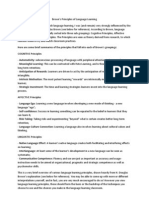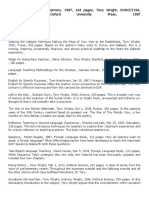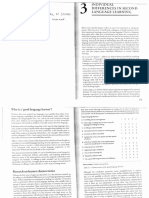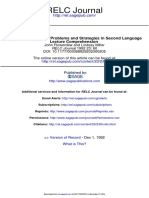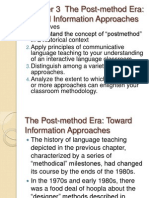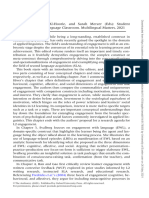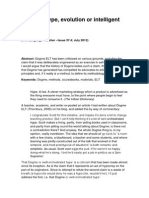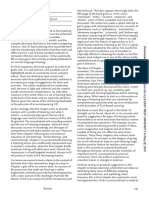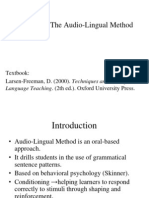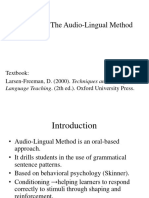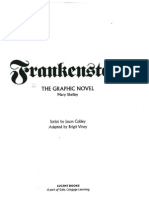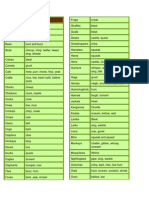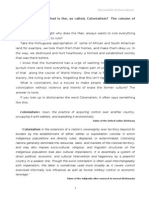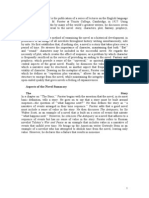0 ratings0% found this document useful (0 votes)
244 views21 pagesHarmer Methods
metodologia enseñanza de ingles
Uploaded by
Leila SantosCopyright
© © All Rights Reserved
We take content rights seriously. If you suspect this is your content, claim it here.
Available Formats
Download as PDF or read online on Scribd
0 ratings0% found this document useful (0 votes)
244 views21 pagesHarmer Methods
metodologia enseñanza de ingles
Uploaded by
Leila SantosCopyright
© © All Rights Reserved
We take content rights seriously. If you suspect this is your content, claim it here.
Available Formats
Download as PDF or read online on Scribd
You are on page 1/ 21
The Practia & :
Erg ow Conguge Teerhig |
Popular ee
Cloaynen
methodology
A Approaches, methods, procedures, and
techniques
This chapter looks at how theory has been realised in methodological practice.
Within the general area of ‘methodology’ people talk about approaches, methods,
techniques, procedures and models, all of which go into the practice of English
teaching, These tetms, though somewhat vague, are definable:
* Approach: this refers to ‘theories about the nature of language and language
learning that serve as the source of practices and principles in language
teaching’ (Richatds and Rodgers 1986: 16). An approach describes how language
s used and how its constituent parts interlock ~ in other words it offers a model
of language competence. An approach describes how people acquire theit
ige ofthe language and makes statements about the conditions which
will promote successful language learning,
‘Method: method is the practical realisation of an approach. The originators
‘of a method have arrived at decisions about types of activities, roles of teachers
and learners, the kinds of material which will be helpful, and some model of
syllabus organisation (see Chapter 214). Methods include various procedures
and techniques (see below) as part of their standard fare
When methods have fixed procedures, informed by a clearly articulated
approach, they are easy to describe, The more all-embracing they become,
however, the more difficult it is to categorise them as real methods in their
own right
Procedure: a procedure isan ordered sequence of techniques. For example, a
popular dictation procedure starts when students are put in small groups. Each
group then sends one representative tothe front of the class to read (and
remember) the frst line of a poem which has been placed on a desk there. Each
student then goes back to their respective group and dictates that line. Each
group then sends a second student up to read the second line. The procedure
nues until one group has written the whole poem (see Example 3 on
page 264
A procedure isa sequence which can be described in terms such as first you
do this, shen you do that... Smaller than a method itis bigger than a technique.
At
* Technique: a common technique when using video material is called ‘silent
viewing! (see Chapter 20, m1). This is where the teacher plays the video with
zo sound, Silent viewing is a single activity rather than a sequence, and as such
isa technique rather than a whole procedure, Likewise the finger technique’ is
used by some teachers who hold up their hands and give each of their five
fingers a word, eg. He is not play
tennis,and then by bringing the isand the
not fingers together, hhow how the verb is contracted into is.
A term that is also used in discussions about teaching is ‘model’ — used to describe
typical procedures or sets of procedures, usually for teachers in training, Such
models offer abstractions of these procedures, designed to guide teaching practice.
Confusion occurs when these models are elevated to the status of methods, since
their purpose is pedagogic in terms of training, rather than inspirational as
statements of theoretical belief
The way in which people announce and develop new teaching practices can make
discussions of comparative methodology somewhat confusing, Some
methodologists, for exampl
have new insights and claim a new approach’ as a
result, Others claim the status of method for a technique or procedure, Some
methods start as procedures and techniques which seem to work and for which an
approach is then developed. Some approaches have to go in seatch of procedures
and te
hniques with which to form a method, Some methods are explicit about the
approach they exemplify and the procedures they employ. Others are not
What the interested teacher needs to do when confronted with a new method, for
example, isto se if and/or how it incorporates theories of language and learning
What procedures does it incorporate? Are they appropriate and effective fort
classroom situation that the teacher works with? In the ase of techniques and
activities, two questions seem worth asking: are they satisfying for both students and
teachers, and do they actually achieve what they set out to achieve?
Popular methodology includes ideas at all the various levels we have discussed,
and itis these methods, procedures, approaches (and models) which influence the
current state of English language teaching.
Audiotlingualism
Audio-lingual methodology owed its existence to the Behaviourist models of
learning that were discussed in Chapter 5a. U
ng the Stimulus-R.
Reinforcement mode, it attempted, through a continuous process of such positive
esponse—
reinforcement, to engender good habits in language learners.
Audio-Ii
alism relied heavily on drills to form these habits; substitution was
built into these drills so that, in small steps, the student was constantly learning and,
the drill
‘The following example shows a typical Audio
Ided from the possiblity of making mistakes by the design of
al drill:
Teacher: There's a cup on the table ... repeat
Students: There's a cup on the table
Teacher: spoon
Students: There's a spoon on the table
Teacher: Book
There's a
jak on the table
On the chair
Students: There's a book on the chair
etc
This kind of patterned drilling has some drawbacks quite apart from whether or
not it can be shown to lead to grammatical and/or lexical mastery of the
structures being focused! on (see Chapter 5a). In th
rst place the langu:
de-contest d carries little com
nunicative function, Second, by doing it
st to banish mistakes, so that stu
is only use correct language, such teaching
runs counter to a belief among many theorists that making (and learning) from |
ervors isa key part of the process of acquisition. Indeed! Audio-lingual methodology
seems to banish all forms of language processing that help students sort out new |
language information in their own minds. |
Despite these reservations, however, habit-forming drills have remained popula
among teachers and students, The theory behind them still informs some taped
materials in language laboratories, for example (see Chapter toe); teachers who fee!
insecure with the relative Ireedoms of some recent methods of
confident with the linguistic restriction of such procedures.
ntation, Practice, and Production
ation on Audio-lingualism in British-based teaching and ¢
procedure most often referred to as PPP, which stands for Presentation, Practice,
ere isthe
and Production. In this procedure the teacher introduces a situation which
contextualises the language to be taught. The language, too, is then presented
The students now practise the language using accurate reproduction techniques
such as choral repetition (where the students repeat a word, phrase, or sentence all
together with the teacher ‘conducting dividual
urging), and
cue-response drills (where the teacher gives a cue such as cinema, nomin
}s individual repetition (where
students repeat a word, phrase, or sentence at the teacher's
a |
s the desired
you like to come to the cinema’). These have similarities with the
classic kind of Audio-ling
student by name
y looking or pointing, and the student mal
response, e.g. Would
al drill we saw above, but
by the situation that has been pr
cause they are contextualised
than a simpl
ake sentences o
substitution drill. Lat
the students, using the new langu:
theit own, and this is referred to as production. The following
‘example demonstrates this procedute:
‘ementary-level
© Presentation: the teacher shows the students the following picture and asks
them whe!
at work or on holiday to elicit
the people in ita fact that |
they are on holiday.
The teacher points to the man and attempts to elicit the phrase He's swimming
t’she
acher then models the sentence (He swinein
before isolating the grammar
by saying Can anybody tell me ... he’... 2or asking the question W
rody? The
¥e wants to focus on (he), distorting it (
he’), and then giving the
), puting
it back together again (1
model in a natural way once more (Listen
ing... he's
She may accompany this demon:
ation of form rules by using some physica
‘means such as bringing two hands (for ke and is) together to show how the
contraction works or by us
finger technique
hapter i, a1)
Practice: the tea
ie students to repeat the s
in chorus. She may then nominate certain students to repe
individually, and she corre
s any mistakes she hears (
goes back and models more sentences
Paul
e Chapter 7), Now she
Mary’s reading a book
m the pictur
id Sarah are playing car
horal and individual repetition
sshere she thinks this is necessary. Now she is in a position to conduct a slightly
freer kind of drill than the Audio-lingual one above:
Teacher: Can anyone tell me? ... Mary? ... Ye
Student: She's reading book.
Teacher: Good, ete
5, Sergio
In this cue-response drill the teacher gives the cue (3)
student (Sergio) who will give the response (
tinga
). By cueing
before nominating she keeps everyone alert. She will i
in a predictable order for the same reason,
ally the teacher puts the students in pairs to
avoid nominating students
bit more before listening to a few examples just to chee!
been effective,
hat the learning has
Production: the end point of the PPP cycle is production
which some trainers
have called ‘immediate creativity
Here the students are asked to use the new
age (in this case the present continuous) in sentences of their own. For
example, the teacher maj
the stuclents to imagine th
AB
holiday villa, They must now say what each of them is doin
book, Juana’s
8, eg, Sergio’ reading
tc. They might write a ‘holiday’ postcard home
eg. It's great here, The sun’s shining. Pa Sarah are playing football. et
cr, by changing the situation, they may be asked to say what they think thei
friends and relations are doing at that moment, e.g. My mother's working atthe
hospital. My father’s driving to London. My
rer's studying. etc.
As we shal se in 43 (below), the PPP procedure has come in for conside
b
criticism over the last few years, especially as a model for teacher traine:
And even when it was at its most popular teachers knew that what might be
appropriate for b and ela
lary students was less likely to find success at
higher levels where accurate reproduction and conttalled repetition seem out of pla
PPP and alternatives to PPP
The PPP procedure came under a sustained attack the 1990s. It was, critics argued
ly teacher-centret
(at leat in the kind of procedure which we have
demonstrated above
therefore sat uneasily in a more humanistic and learne
centred framework. It also seems to assume that students learn ‘in straight lines’ —
fom no knowk
through hi
trera
es and on to immediate production. Yet human,
ng probably is not lke
thats it is more random, more convoluted. And, by bre down into
small pieces to learn them, it may be cheating the students ofa language which, in
Tessa Wood odward
1993: 3). Michael Lewis suggested that PPP was inadequate because it reflected
1's phrase, is full of ‘interlocking variables and systems (W.
neither the nature of language nor the nature of learning (Lewis 1993 190),
trainer, Jim Scrivener, even wrote that‘it is fundamentally dis
(Scrivener 1994a: 15) Later however, Scrivener advanced w
worrying aspect of PPP, the fact that i
tis perhaps the mast
only describes one kind of lesson; itis inadequate as a general proposal
concerning approaches to language in the classroom. Tt entirely fils to
describe the many ways in which teachers can work when, for example
using coursebooks, or when adopting a task-based approach
From J Scrivener (997
This, then,
course these days offers an undiluted diet of the dry meaning
s the problem. Despite writer Andy Hopkins’ assertion that ‘no language
ss PPP-structured
lessons that so many commentators like
» sel up as a straw-man foe’ (1995: 1), large
numbers of trainers and trainees still use it as the main default model for the
teaching of new lai
ige forms.
In response to these and ear
PPP and alternatives
lier criticisms many people have offered variations on
it. Keith Johnson offered the ‘de
tive (Johnson 1982: Chapt
smmediate production (throwing them in at the deep end
-end strategy’ asan
al
ing the students into
) you turn the procedure
on its head. The teacher can now see if and where students are having problems
g this production phase and return to either presentation or practice as and
when ne
sary after the production phase is over. A few years later Donn Byrne
suggested much the same thing (Byrne 1986: 3), joining the three phases ina circle
(sce Figure 13). Teachers and students can decide at which stage to enter the
HiGURe 13: Byme’ alternative approach’
However, more recent models, usually designed for trainin
further than this:
purposes, have
‘© ARC: put forward by Jim Scrivener (1g94b), this stands for Authentic use
Restricted use, and Clarification and focu
s. The basic premise here is that most
language in the classroom can be described as either A, R, or C. Thus a
communicative activity will demonstrate ‘authentic’ use, whereas a drill, jazz
chant elicited dialogue or guided writing, for example, will provoke restricted
use of language by students, Finally Clarification language is that which the
teacher and students use to explain gram) r
nar, give examples, analyse errors,
.
clicit oF repeat things
By labelling different parts of any lesson in this way Scrivener is abl
cto
describe lessons differently from the old PPP procedure. An old PPP-type
lesson can now be described as CRA (wh
point, institutes restricted (controlled) practice, before
getting ‘authentic’ use), whereas a different lesson ~ for example, a task-base
lesson ~ might follow a procedure such as CACACR. By introducing
terminology, Scrivener forces us to look at things differ
the teacher presents a situation,
tly, and by producing
descriptive rather than a prescript
into w
tool, he is attempting to offer an insight
he called ‘the many ways in which teachers can work.
© OHE/IE: Michael Lewis claims that students should be all
(ead or listen to language) which will then provoke
wed to Observe
em to Hypothesise about
» Experiment on the basis of that
how the language works before going on
hypothesis, Such a description is close to the III of McCarthy and Carter
(McCarthy and Carter 1995) where they show students examples of langu
like the transcripts of conversations (Illustration); they then give them
discovery activities and questions about the lang for example How would
Aa
poken langu (Interaction) as a result of which,
trough such a noticing routine, stud
ts will grasp new facts about language
(Induction), We saw an example of the kind of
transcript material they migh
ask stud
s to study in Chapter 2, a1
‘* BSAt in the ESA model (see Harmer 1998)
present in any teachin
ee components will usually be
sequence, whether of five, fifty, or a hundred minutes.
E stands for Engage. The point here is that unless stu
sare engaged,
ning willbe less effective
emotionally, with what is going on, their le
S stands for Study and describes any
aching a
the focus is on how something is constructed, whethe
specific intonation patterns, th
learning element where
it is relative clauses,
nstruction of a paragraph or text, the
way a lexical phrase is made and used, oF the collocation possibilities ofa
particular word
dents are
A stands for Activate and this means any stage at which
encouraged to use all and/or any of the language they know. Communicative
activities, for example,
igned to activate the students’ a
knowledge: so too are reading and listening activities when students are doing it
for interest and general understand)
in Chapters, ax
uch as the extensive reading we discuss
ESA allows for three basic lesson procedures, In the frst (‘stra
the sequence is ESA, much like PPP or CRA (see above). A ‘boomerang
procedure, on the other hand, follows a more task-based or deep-end approach
{ere the order is EAS, so that the teacher gets the students engaged
asking them to do something like a written task, a communic
role-play. Based on what happens there the students will then, aftr the activity
haas finished, study some aspect of language which they lacked or which they
used incor
atchwork’lessons, on the
sequences such as ones where eng
other hand, may follow a variety of
ed students are encouraged to activate theit
knowledge before studying one and then another language element, and then
returning to more active ta
after which the teacher re-engage before
doing some more study, etc.
What allt
a number of teaching procedures for the teacher to employ-~ rather than the central
plank of good teaching, The goal is flexibility, not rigidity.
hese models demonstrate isa desire to put PPP firmly in its place as one of
The Communicative approach
The Communicative approach ~ or Communicative Language Teaching (CLT) —is the
name which was given to a set of beliefs which included not only a re-examination of
what aspects of language to teach, but also shift in emphasisin how to teach,
The what to teach’ aspect of the Communicative approach stressed the
significance of language functions (see Chapter 2,2) rather than focusing sole
grammar and vocabulary. A guiding principle was to train students to use these
language forms appropriately ina variety of contexts and fora varity of purposes.
a
The “how to teach aspect’ of the Communicative approach
idea that ‘Tanguage learning will take care of itself (see Chapt
is closely related to the
fer 58), and that
Plntifl exposure to language in use and plenty of opportunities to seit are vitally
mportant fora student's development of knowledge and skil
I. Activities in CLT
typically involve students in real or realistic communication, where the accuracy
of the language they use i es important than successful achievement of the
communicative task they are performing. Thus role-play and
Chapter 19, 36) have hecome very poy
lar in CLT, where stu
simulation (
dents simulate a
‘clevision programme ora scene at an airport — or they might put together the
lated front page of a newspaper. Sometimes they have 10
can only do so by sharing information. Sometimes they have
uct a story together.
solve a puzzle and
to writea poem or
What matters in these activities is that students should have a desire to
something. They should have a purpose for con
mmunicating (eg. to
Jnske @ point to buy an airline ticket, or write a letter toa newspaper), Th ey should
sed on the content of what they are saying or writing 1
Particular language form. They should use a varity of angua
Innguage structure. The teacher will not intervene to stop the
ather than on a
ige rather than just one
activity; and the
materials he or she relies on will not dictate what specific language forms the
students use either. In other words such activities should atten
real communication, All this is seen as being in marked contr.
{caching and learning we sw in at and a2 above. They are a opposit
‘communication continuum’ (see Figure 14
Non-communicati
activities Communi
‘+ no communicative purpose
| * form not content content
| £ one language tem only variety
‘teacher intervention
no teac
| + materials control | + no materials control
Notall activities occur at either extren
be further towards the con
nunicative end, whereas some ma
mnicative, An activity in which students have to go round
You might also like
- 2.4 Teaching Large Multilevel Classes - Nathalie Hess PDF100% (1)2.4 Teaching Large Multilevel Classes - Nathalie Hess PDF15 pages
- McGrath Feeding Leading. Showing Throwing p162-172 V 2100% (1)McGrath Feeding Leading. Showing Throwing p162-172 V 211 pages
- EFL Students' Perspective On The Use of Wordwall - Net As Vocabulary Learning MediaNo ratings yetEFL Students' Perspective On The Use of Wordwall - Net As Vocabulary Learning Media10 pages
- Cambridge English Qualifications OrientationNo ratings yetCambridge English Qualifications Orientation46 pages
- Cook Using The First Language in The Classroom 1 PDF100% (1)Cook Using The First Language in The Classroom 1 PDF22 pages
- Student Teaching Lesson Plan - Turn TakingNo ratings yetStudent Teaching Lesson Plan - Turn Taking5 pages
- Strategies in Learning and Use A Second Language PDFNo ratings yetStrategies in Learning and Use A Second Language PDF23 pages
- Butler, YG (2011) The Implementation of Communicative and Task-Based Language Teaching in The Asia-Pacific RegionNo ratings yetButler, YG (2011) The Implementation of Communicative and Task-Based Language Teaching in The Asia-Pacific Region22 pages
- Movement and Action - Action-Based Learning in The ClassroomNo ratings yetMovement and Action - Action-Based Learning in The Classroom36 pages
- Delta Module Three Principal Examiners Report June 2009No ratings yetDelta Module Three Principal Examiners Report June 200920 pages
- Chapter 4: Assessing Listening Skills: Exercise 1: Match The Six Types of Listenning (1-6) To The Examples (A-F)No ratings yetChapter 4: Assessing Listening Skills: Exercise 1: Match The Six Types of Listenning (1-6) To The Examples (A-F)4 pages
- A Book I've Used - ETpedia Business English - MET PDFNo ratings yetA Book I've Used - ETpedia Business English - MET PDF2 pages
- Richards (1990) Design Materials For Listening PDF100% (2)Richards (1990) Design Materials For Listening PDF18 pages
- TESOL Pre Interview Language Awareness Task 2016No ratings yetTESOL Pre Interview Language Awareness Task 20166 pages
- Autonomy and Motivation-Literature ReviewNo ratings yetAutonomy and Motivation-Literature Review10 pages
- Student Engagement in The Language ClassroomNo ratings yetStudent Engagement in The Language Classroom5 pages
- Hughes Summary - Testing For Language TeachersNo ratings yetHughes Summary - Testing For Language Teachers2 pages
- Helping Low - Level Learners Use Bottom-Up Processing Strategies To Understand Reading TextsNo ratings yetHelping Low - Level Learners Use Bottom-Up Processing Strategies To Understand Reading Texts12 pages
- Dogme Hype, Evolution or Intelligent DesignNo ratings yetDogme Hype, Evolution or Intelligent Design4 pages
- Ch4 Lesson Planning Procedures by Jeremy HarmerNo ratings yetCh4 Lesson Planning Procedures by Jeremy Harmer12 pages
- Chapter 4: The Audio-Lingual Method: Textbook: Larsen-Freeman, D. (2000) - Techniques and Principles inNo ratings yetChapter 4: The Audio-Lingual Method: Textbook: Larsen-Freeman, D. (2000) - Techniques and Principles in17 pages
- Why Exists and What Is The, So Called, Colonialism? The Column of My OpinionNo ratings yetWhy Exists and What Is The, So Called, Colonialism? The Column of My Opinion3 pages
- Aspects of The Novel Is The Publication of A Series of Lectures On The English LanguageNo ratings yetAspects of The Novel Is The Publication of A Series of Lectures On The English Language1 page

